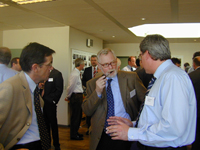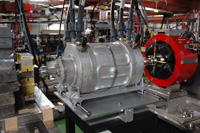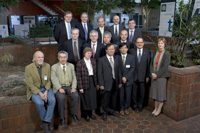 |
|
|
 |
European SCRF Forum Founded at DESY

Forum's chairman Dieter Trines (in the centre) during coffee break.
|
On 27 October, 61 participants, representing 34 companies and institutes from nine countries, attended the foundation of the European SCRF Forum. The meeting ended with the election of the collaboration board, which will be chaired by Dieter Trines and the Forum’s statutes were unanimously accepted. During the meeting, discussions were very constructive and all attendees recognized the pragmatism of the speakers during their presentations.
The motivations for such a Forum were clearly summarized by DESY Director Albrecht Wagner. There is a substantial industrial interest in Europe for Superconducting RF, and Europe had a very good start in this technology. “We have to strengthen our efforts in this area, so that Europe can maintain its leading role for SCRF”, said Wagner. One of the tasks of the Forum will be to provide a point of contact between European accelerator laboratories, industry and also laboratories from Asia and Americas. It also aims to intensify discussions between science, industry and politics and also to develop ways of cooperation and knowledge transfer.
The main future projects based on superconducting RF linear accelerators are the XFEL and the ILC. “There will be a natural information transfer between XFEL and ILC”, said Wagner. Brian Foster, Regional ILC GDE Director for Europe, emphasized that building an industrial plan was part of the mission of the GDE. The XFEL schedule, presented by XFEL Project Team Leader Massimo Altarelli, should give momentum to the relationship with industry, since contracts should be signed before 2007. “The XFEL and VUL-FEL [Vacuum UltraViolet Free Electron Laser] will consist in a sort of proof of principle that will naturally lead ILC to follow it”, said Foster.
Undoubtedly, the Forum will soon raise its visibility, becoming part of the European Union programme: It has just been agreed by the Electron Linear Accelerator Network (ELAN).
The Forum website should become a reference for future participants where they will find practical information on participation and contribution processes.
Photo page
Slides
--Perrine Royole-Degieux
|
 |
|
|
 |
Upcoming meetings, conferences, workshops
ECFA ILC Workshop
Vienna, Austria, 14-17 November 2005
CARE 05
CERN, Switzerland, 23-25 November 2005
Mini Workshop on Design
for High Availability
Hotel CARAT at Grömitz (located at the Baltic
Sea), 1-2 December 2005
ILC Spanish Meeting
Gandia, Spain, 1-3 December 2005
TESLA Technology Collaboration Meeting
Frascati, Italy, 5-6 December 2005
GDE Meeting
Frascati, Italy, 7-10 December 2005
American Linear Collider Physics Group - Detector Simulation Workshop
Colorado, U.S.A., 9-11 January 2006
2006 LCWS 2006
Bangalore, India, 9-15 March 2006
International School for Linear Colliders
Sokendai, Graduate School for Advanced Studies
Hayama, Japan, 19-26 May 2006
|

Accelerating module of the TESLA Test Facility illuminated in red and blue.
|
|
 |
Petronzio Opens Dialogue Between GDE and FALC

The current chairman of FALC, Roberto Petronzio (left), with the Fermilab Director Pier Oddone.
|
On Friday, 4 November, the Funding Agencies for the Linear Collider (FALC) met at Fermilab. At the meeting, representatives from funding agencies and governments around the world discussed the various issues involved with funding an International Linear Collider.
"We want to be prepared to respond to the needs of the ILC", said Roberto Petronzio, President of INFN and the newly appointed chair of FALC. "At this meeting we wanted to better clarify the roles between the various actors in the game. It was particularly useful to clarify the relationship with ICFA."
Read more...
--Elizabeth Clements
|
 |
|
|
 |
LCSGA and GDE Outline R&D Proposal Process for FY2006
The Linear Collider Steering Group of the Americas and the International Linear Collider Global Design Effort are now soliciting proposals for U.S. university-based detector and accelerator R&D for FY2006. The review committees welcome continuing and new proposals for ILC related projects.
This year the ILC accelerator R&D projects will adopt the umbrella grant proposal process, following the model currently in place for the ILC detector R&D projects. Under the new guidelines for ILC accelerator R&D, a single university will submit umbrella grant proposals for ILC R&D to both DOE and NSF. Approved projects will be funded through the prime contract university, who will then distribute subcontracts to the institutions responsible for the work.

Jim Brau
|
"The umbrella grant proposal process creates a coordinated R&D effort that can prioritize the program from the community perspective," said physicist Jim Brau of the University of Oregon, who is coordinating the ILC detector R&D proposal process.
Read more...
--Elizabeth Clements
|
 |
|
|
 |
Ten Millionth of a Second

The kicker magnet.
|
A team of accelerator physicists from KEK and SLAC succeeded in extracting a few bunches of ultra-low emittance electron beam with the same bunch spacing that the ILC would have.
The Accelerator Test Facility (ATF) is a unique place to test cutting edge accelerator technologies that are required for the ILC. It has a beam line to develop and test various kinds of new beam diagnostics monitors and apparatus for the beam stabilization with the ultra-low emittance beam from the damping ring.
Read more...
--Youhei Morita
|
From FYI
The American Institute of Physics Bulletin of Science Policy News,
9 November 2005
Better Than Expected: Congress Provides 3.0% Increase for NSF in FY 2006
House appropriations subcommittee chairman Frank Wolf (R-VA) and Senate
appropriations subcommittee chairman Richard Shelby (R-AL) and their
colleagues have completed work on the FY 2006 Science, State, Justice
and Commerce Appropriations Act for FY 2006.
Read more...
|
|
 |
 |
|
|
 |
Funding Agencies for the Linear Collider
All of us recognize that the ILC will be too expensive to be undertaken by one country or even probably, by one region. For that reason, ground-breaking steps have been taken to internationalize the effort from the very beginning. This means the parameters of the machine, the concepts, the technologies, as well as the organization are being determined through an international framework set-up and guided by the International Committee for Future Accelerators (ICFA). In my last column, I described ICFA and its connection to the International Union of Physics and Applied Physics (IUPAP), which is the primary international organization of physicists.
The ideas and early R&D toward a TeV scale linear collider were developed regionally at DESY, KEK and SLAC. As the concept developed, steps to bring these efforts together and to make it a truly global were undertaking. ICFA, through a subcommittee, obtained a worldwide consensus on the parameters or requirements for the machine and they setup another subcommittee, the International Linear Collider Steering Committee (ILCSC) to coordinate the international program. ILCSC appointed a committee to make the decision between the two competing technologies and more recently, formed the GDE.
ICFA has no funds even for the R&D, let alone for the ILC itself. The ongoing ILC R&D program is supported through the traditional funding to our particle physics laboratories and universities. In order to begin to develop international funding mechanisms for the ILC, a group of representatives of funding agency and governments called Funding Agencies for the Linear Collider (FALC) was formed. Ian Halliday, then of PPARC in the UK, took the lead in creating this group and chaired the meetings until he retired from his PPARC position earlier this year. Roberto Petronzio, President of the INFN in Italy, has taken over as the new chair of FALC and he is interviewed separately in this issue of ILC NewsLine.

Representatives from the FALC meeting that was held on Friday, 4 November at Fermilab.
|
Even though FALC is just an informal group, the fact is that we have an established mechanism for carrying out a dialogue with the funding agencies and between the funding agencies regarding the ILC. They are engaged in the process of creating a technical design that will be the basis of a funding proposal and this is a crucially important development. At the FALC meeting held at Fermilab this past week, I reported in detail on the progress and plans for the GDE and Shin-ichi Kurokawa participated and reported on ILCSC activities. Issues being discussed by FALC included how to create a "common fund" for the GDE and when and how a more centrally funded management will be needed for the GDE.
--Barry Barish
Director's Corner Archive
|
 |
|
|
 |
|
ILC Related Preprints
hep-ph/0511006 - Determination of MSSM Parameters from LHC and ILC Observables in a Global Fit, 1 Nov 2005
physics/0511038 - General Thoughts about Tracking for a Linear Collider Detector, 4 Nov 2005
physics/0511039 - Progress Towards a Long Shaping-Time Readout for Silicon Strips, 4 Nov 2005
|
|

